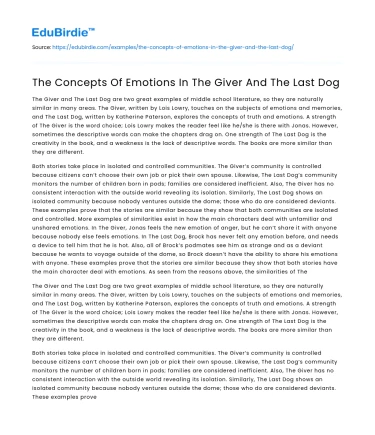The Giver and The Last Dog are two great examples of middle school literature, so they are naturally similar in many areas. The Giver, written by Lois Lowry, touches on the subjects of emotions and memories, and The Last Dog, written by Katherine Paterson, explores the concepts of truth and emotions. A strength of The Giver is the word choice; Lois Lowry makes the reader feel like he/she is there with Jonas. However, sometimes the descriptive words can make the chapters drag on. One strength of The Last Dog is the creativity in the book, and a weakness is the lack of descriptive words. The books are more similar than they are different.
Both stories take place in isolated and controlled communities. The Giver’s community is controlled because citizens can’t choose their own job or pick their own spouse. Likewise, The Last Dog’s community monitors the number of children born in pods; families are considered inefficient. Also, The Giver has no consistent interaction with the outside world revealing its isolation. Similarly, The Last Dog shows an isolated community because nobody ventures outside the dome; those who do are considered deviants. These examples prove that the stories are similar because they show that both communities are isolated and controlled. More examples of similarities exist in how the main characters deal with unfamiliar and unshared emotions. In The Giver, Jonas feels the new emotion of anger, but he can’t share it with anyone because nobody else feels emotions. In The Last Dog, Brock has never felt any emotion before, and needs a device to tell him that he is hot. Also, all of Brock’s podmates see him as strange and as a deviant because he wants to voyage outside of the dome, so Brock doesn’t have the ability to share his emotions with anyone. These examples prove that the stories are similar because they show that both stories have the main character deal with emotions. As seen from the reasons above, the similarities of The
The Giver and The Last Dog are two great examples of middle school literature, so they are naturally similar in many areas. The Giver, written by Lois Lowry, touches on the subjects of emotions and memories, and The Last Dog, written by Katherine Paterson, explores the concepts of truth and emotions. A strength of The Giver is the word choice; Lois Lowry makes the reader feel like he/she is there with Jonas. However, sometimes the descriptive words can make the chapters drag on. One strength of The Last Dog is the creativity in the book, and a weakness is the lack of descriptive words. The books are more similar than they are different.
Both stories take place in isolated and controlled communities. The Giver’s community is controlled because citizens can’t choose their own job or pick their own spouse. Likewise, The Last Dog’s community monitors the number of children born in pods; families are considered inefficient. Also, The Giver has no consistent interaction with the outside world revealing its isolation. Similarly, The Last Dog shows an isolated community because nobody ventures outside the dome; those who do are considered deviants. These examples prove that the stories are similar because they show that both communities are isolated and controlled. More examples of similarities exist in how the main characters deal with unfamiliar and unshared emotions. In The Giver, Jonas feels the new emotion of anger, but he can’t share it with anyone because nobody else feels emotions.
In The Last Dog, Brock has never felt any emotion before, and needs a device to tell him that he is hot. Also, all of Brock’s podmates see him as strange and as a deviant because he wants to voyage outside of the dome, so Brock doesn’t have the ability to share his emotions with anyone. These examples prove that the stories are similar because they show that both stories have the main character deal with emotions. As seen from the reasons above, the similarities of The Giver and The Last Dog overpower the differences.






 Stuck on your essay?
Stuck on your essay?

